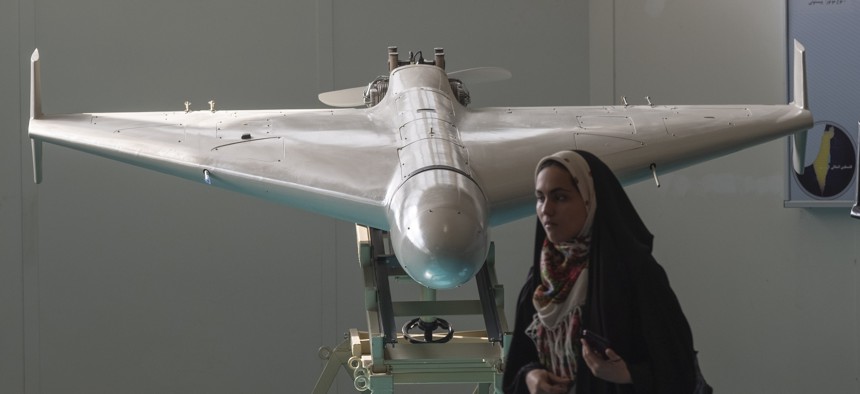
A veiled Iranian schoolgirl stands in front of Iran's Shahed-136 unmanned aerial vehicle while visiting of Iran's Islamic Revolutionary Guard Corps (IRGC) National Aerospace Park in western Tehran, October 11, 2023. Morteza Nikoubazl/NurPhoto via Getty Images
Russia may be trying to build 10,000 attack drones a year for use in Ukraine
A purported cache of stolen Iranian documents also suggests Moscow is paying a lot more than expected.
Is Russia aiming to build 10,000 Shahed-136 loitering munitions a year?
Plans for massive domestic production of the 200-kg, 2,500-km Iranian-designed suicide drones—and the high price Moscow is paying for them—are just two of the purported revelations of files that an Iranian hacking group says it stole from a company controlled by Tehran’s leading paramilitary arm.
On Feb. 4, the Prana hacking group released thousands of emails and multiple documents that it claimed to have purloined from Sahara Thunder, which it calls a front company for the Islamic Revolutionary Guard Corps. Defense One could not confirm the authenticity of the documents.
Much of the metadata of the files had been deleted, making it difficult to determine whether the files were authentic, said Ruslan Trad, a resident fellow at the Atlantic Council’s Digital Forensic Research Lab.
One of the documents, dated “November 2022,” describes a trip to Iran earlier that year by employees of Alabuga, a state-owned company that manages a large industrial park in Russia. In August 2023, the Washington Post reported, citing its own leaked documents, that Alabuga was central to a plan to build 6,000 Shahed-136s.
The file posted by Prana said Russia had agreed to buy the technology and components to assemble 6,000 “Dolphin 632 boats.” It also said Russia would produce up to 10,000 a year once it had received all the relevant technology.
But numerous details in the Prana files suggest that these “boats” are in fact UAVs. The “November 2022” document, for example, lists such components as “avionics,” jet-assisted take-off, and a Nassir-2 anti-jamming system.
A separate, Alabuga-branded slideshow titled “Factory Production,” describes the “boat” as including a fuselage and elevons. Their construction requires specialists in “REB,” a Russian acronym referring to electromagnetic warfare.
Other documents, by contrast, seemed to go into exhaustive detail to try to hide that the boat is a drone, with one production schedule listing various boat-related parts.
It is unclear whether the “Dolphin 636” is the Shahed-136, although other documents in the Prana dump explicitly discuss the drone’s technical characteristics. One Alabuga-branded slideshow, "motor boat production technology,” offers multiple images of the propeller-driven aircraft.
And if the drone is in fact the Shahed-136, the documents suggest that Moscow has paid a heftier-than-expected price for the weapon, which it has used in large numbers during its invasion of Ukraine.
Iran initially wanted to charge Moscow a licensing and component fee of $375,000 to assemble each Shahed-136 in Russia, which negotiated that down to $193,000 apiece for 6,000 drones, according to the “November 2022” document.
That price is six times the previously estimated cost of the drone, which is made from low-cost components and carries a 40-kilogram warhead.
Many of the components can be acquired locally, with around 10 percent of components coming from abroad, according to the document.
Russia is also seeking to license-produce several other types of Iranian drones, according to a document titled “April 2023.” These include two variants of a “236” drone—one turbo-powered, and one piston-powered with a “seeker”—and type “107” reconnaissance and strike drones.
The 107 is presumably the Shahed-107 drone, while the 236 is likely in the same product family as the jet-powered Shahed-238.
The prices for the 236 seeker variant is given as $900,000, $1.4 million for the 236 turbo-jet, and $460,000 for the 107 drone, according to the document. The price of the 236 turbo-jet makes it more expensive than the estimated cost of Russia’s Kalibr cruise missile.
The document also said the delivery schedule would depend on its “partner’s” production capabilities. For each category of drone, deliveries would be between ten and 100 per month for the next six months, but eventually ramp up to hundred per month, for a total of 2,130 of the 236 seekers, 677 of the 236 jet-powered drones, and 3,360 of the type 107 drones.
The Shahed-136 reportedly has a range of 1,500 miles, but its top speed is just over 100 miles an hour, making it an easy target for Ukrainian air defenses. In one attack in November, officials claim to have destroyed 74 of 75 incoming drones. Russia has occasionally been successful in using the drone against Ukraine’s infrastructure, including one attack that knocked out Odesa’s electrical system.




